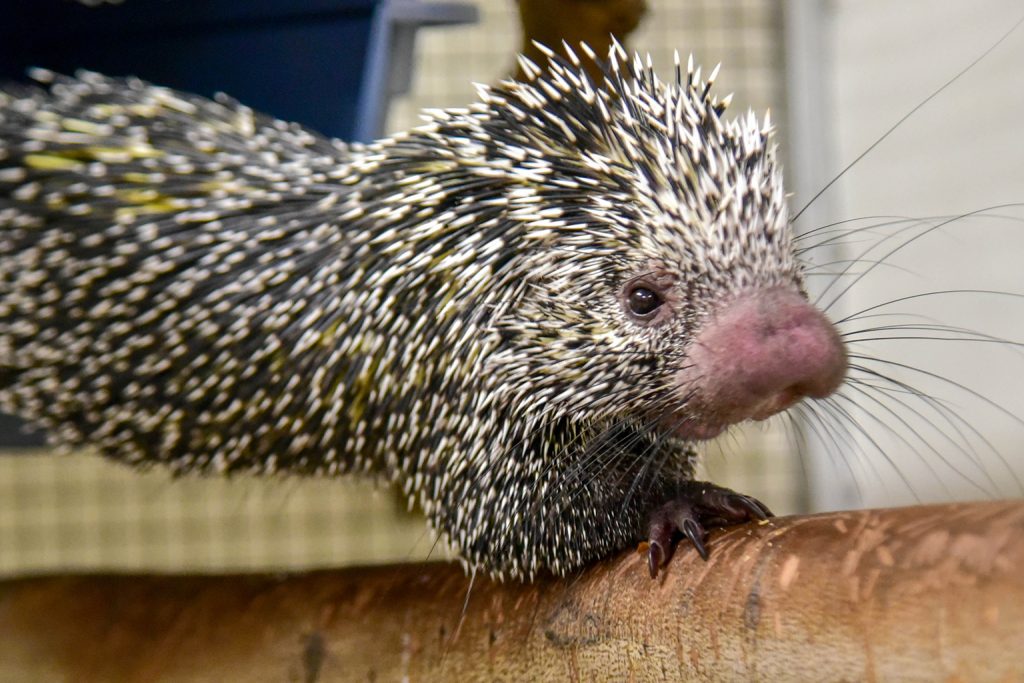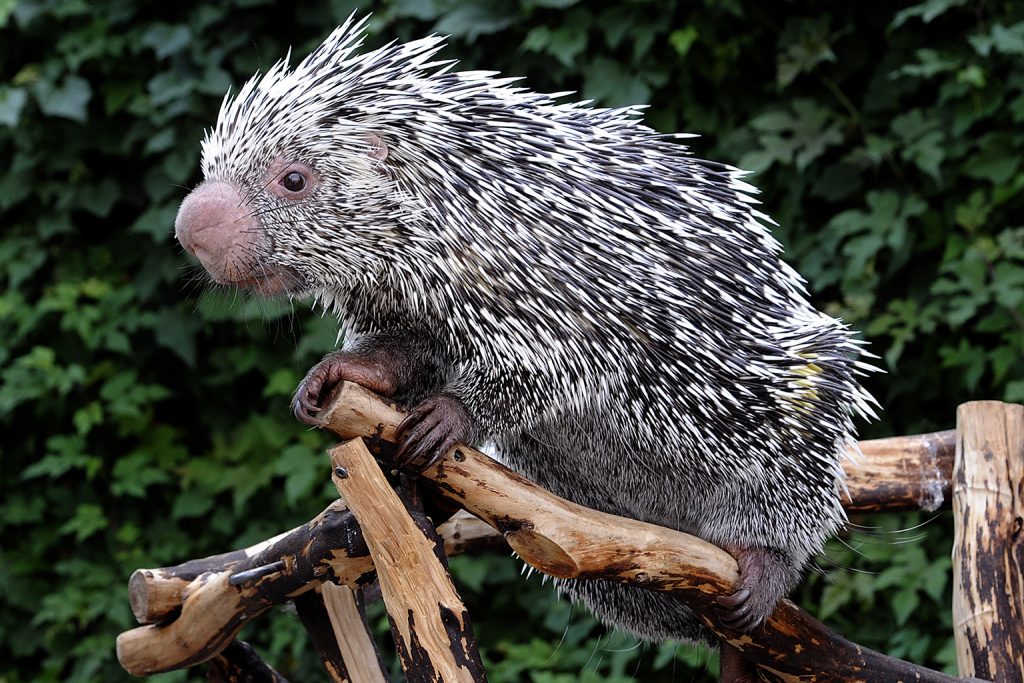Overview
“Where I live”
Prehensile-tailed porcupines are a New World species native to South America. They live in forests up to 8,000 feet in elevation. They live in trees and rarely descend to the ground.
This species of porcupine is featured in The Maryland Zoo’s Animal Embassy collection. Zoo educators introduce the prehensile-tailed porcupine and other Animal Ambassadors to audiences in education programs on and off grounds.
“How I live there”
Study a prehensile-tailed porcupine closely and you will appreciate that this animal was made for climbing in trees and for getting around in the dark. It is well adapted to being a nocturnal and arboreal creature.
Its feet have long, curved claws that help it to climb and balance in trees. It uses its long, bare, prehensile tail to grasp branches, to balance when moving through the trees, and to hang upside down (and be in position to reach out with front feet to grasp food!)
Like many nocturnal animals, the prehensile-tailed porcupine has poor eyesight but keen senses of touch, hearing, and smell.
During the day, prehensile-tailed porcupines sleep, sometimes in small groups. They are difficult to spot because they usually rest high up in the trees or in hollow tree cavities. They do not move much and blend in well with their surroundings.
At night, they wake up and forage for food. They move slowly but with great ease through the trees, and usually forage alone or in pairs. They eat bark, leaves, fruit, buds, and root vegetables. They normally descend to the ground only when they cannot span a gap between trees. They have to walk over to the next tree because they cannot jump!
“Making my mark”
Prehensile-tailed porcupines are covered in short, thick spines that give them a speckled appearance. The spines vary in color from cream to yellow to brown to almost black. The spines normally lay flat, but are raised when the animal feels threatened.
Prehensile-tailed porcupines do not take well to being threatened. They stamp their hind feet, growl, cry, and sit on their haunches and shake their spines. They raise their spines to appear larger and more threatening. They will bite and strike predators that try to attack them. As a last resort, they will curl up into a ball so as to expose their spines on all sides. They cannot shoot their spines (no porcupine can, that is just myth), but their spines release easily and become imbedded in the skin of a predator, causing significant pain.
“What eats me”
Certain forest-dwelling mammals and birds of prey may try to attack a prehensile-tailed porcupine, but it usually does not end well for the predator. Prehensile-tailed porcupines are rodents that defend themselves very successfully. They are less successful when confronted by human hunters, and they are hunted as food in parts of their range.
Raising Young
Very little is known about how prehensile-tailed porcupines court each other because courtship has not been well observed in the wild. They also have no regular breeding season.
A female will usually give birth to a single offspring. The baby porcupine is hairy, reddish-orange, and weighs about 14 ounces at birth. It is born with its eyes open and can climb almost immediately. Its spines will harden within about one week and in time the baby porcupine will change color.
Females nurse their young until about 3 months of age. The young will reach adult size in less than a year, and will reach sexual maturity in less than two years.
Conservation
These animals are not listed as threatened or endangered, but are pressured by habitat loss and are killed in parts of their range by hunters.
Taxonomy
- Kingdom: Animalia
- Phylum: Chordata
- Subphylum: Vertebrata
- Class: Mammalia
- Genera: Coendou
- Species: prehensilis
What is an Animal Ambassador?
The Maryland Zoo refers to its special collection of education program animals as “Animal Ambassadors.” The Zoo currently cares for more than 60 Animal Ambassadors, representing more than 40 species, both native and exotic. These animals are managed separately from the rest of the Zoo’s collection and cannot be seen on exhibit at the Zoo. However, many can be seen up close and personal on a rotating basis at Creature Encounters, the Zoo’s outdoor education center; at camp and school programs at the Zoo; as featured participants in community-based Outreach programs; and at special events on and off Zoo grounds.
Animal Ambassadors spend countless hours working with their human handlers, developing bonds of trust and communication that will allow them to appear in front of audiences large and small. They are not show animals. They behave naturally, focusing audiences’ attention on their natural behaviors and adaptations and giving living, breathing meaning to concepts and topics that students may be studying.
Animal Ambassadors travel all over the state of Maryland and beyond, and many also make local and national media appearances, educating about wildlife while representing the Zoo and its commitments to animal welfare and conservation.
What is The Animal Embassy?
The Animal Embassy at The Maryland Zoo is an off-exhibit area that is not open to the public. It is where the Zoo’s “Animal Ambassadors,” or education program animals, live. The Embassy is home to more than 60 individual animals representing more than 40 different species. It is staffed by its own dedicated group of keepers and volunteers and has both indoor and outdoor living space for the animals.



